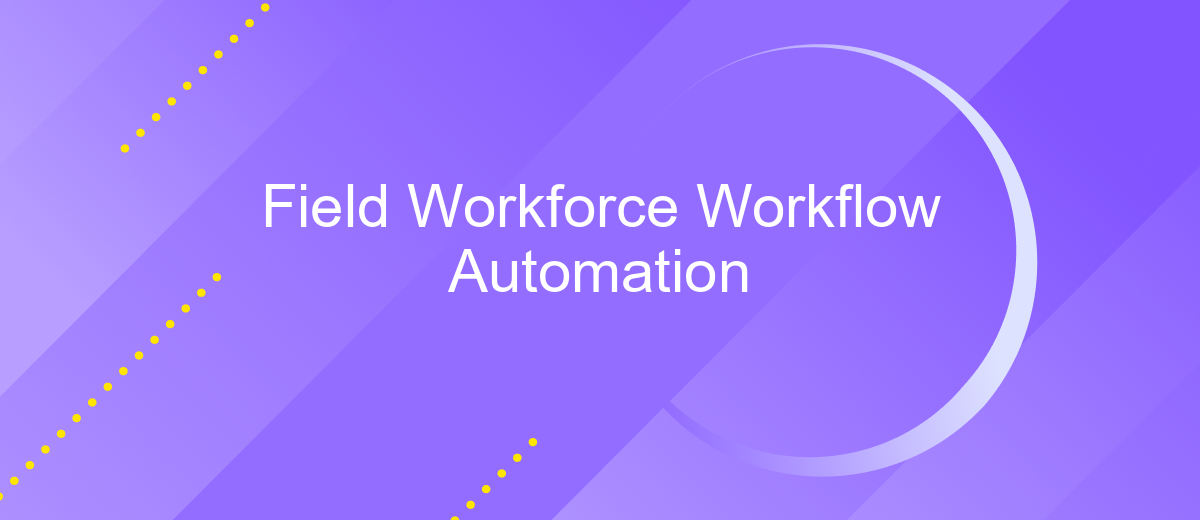Field Workforce Workflow Automation
In today's fast-paced business environment, efficient management of field workforce activities is crucial for maintaining productivity and customer satisfaction. Field workforce workflow automation leverages advanced technologies to streamline operations, reduce manual tasks, and enhance real-time communication. By automating routine processes, companies can optimize resource allocation, improve service delivery, and gain a competitive edge in their respective industries.
What is Field Workforce Workflow Automation?
Field Workforce Workflow Automation refers to the use of technology to streamline and optimize the various tasks and processes that field workers perform. This automation aims to enhance efficiency, reduce errors, and improve overall productivity by minimizing manual interventions and standardizing workflows.
- Task Scheduling: Automate the assignment and scheduling of tasks to field workers based on their availability and skill set.
- Data Collection: Utilize mobile devices and applications to gather real-time data from the field, reducing paperwork and manual data entry.
- Communication: Enhance communication between field workers and office staff through instant messaging and automated updates.
- Reporting: Generate automated reports to track performance metrics and identify areas for improvement.
- Integration: Use services like ApiX-Drive to seamlessly integrate various tools and platforms, ensuring a cohesive workflow.
By implementing Field Workforce Workflow Automation, organizations can significantly reduce operational costs, improve service delivery, and ensure that field workers can focus on high-value tasks. Tools like ApiX-Drive facilitate the integration of different systems, making it easier to manage and automate workflows without the need for extensive coding or technical expertise.
Benefits of Field Workforce Workflow Automation

Field workforce workflow automation significantly enhances operational efficiency by streamlining routine tasks and reducing manual intervention. This automation minimizes errors, accelerates task completion, and ensures that field workers can focus on high-priority activities. By integrating automation tools, companies can optimize scheduling, improve communication, and ensure real-time data updates, which leads to better decision-making and overall productivity.
Furthermore, integrating services like ApiX-Drive allows seamless connectivity between various software and applications used in field operations. ApiX-Drive facilitates the automatic transfer of data between systems, eliminating the need for manual data entry and reducing the risk of discrepancies. This integration ensures that all team members have access to up-to-date information, enhancing coordination and responsiveness. Ultimately, field workforce workflow automation leads to cost savings, improved service quality, and higher customer satisfaction.
Types of Field Workforce Workflow Automation Software

Field workforce workflow automation software helps streamline and optimize the operations of field workers, enhancing efficiency and productivity. These tools can be categorized based on their functionalities and the specific needs they address.
- Task Management Software: This type of software assists in assigning, tracking, and managing tasks for field workers. It ensures that all tasks are completed on time and provides real-time updates on their status.
- Scheduling and Dispatching Tools: These tools help in planning and dispatching field workers to various job sites. They optimize routes and schedules, reducing travel time and costs.
- Mobile Workforce Management Apps: These applications enable field workers to access job details, update task statuses, and communicate with the office while on the go. They are crucial for maintaining real-time communication and data exchange.
- Integration and Automation Platforms: Services like ApiX-Drive facilitate the integration of various tools and systems, automating data flow between them. This reduces manual data entry and ensures seamless operation across different software solutions.
By leveraging these types of field workforce workflow automation software, organizations can significantly enhance their operational efficiency, reduce costs, and improve service delivery. Each type of software offers unique benefits, and choosing the right combination can lead to a more streamlined and productive field workforce.
How to Choose the Right Field Workforce Workflow Automation Software

Choosing the right field workforce workflow automation software can significantly enhance your team's efficiency and productivity. To make an informed decision, start by identifying your specific needs and objectives. Consider the size of your workforce, the complexity of your tasks, and the level of automation required.
Next, evaluate the software's features and compatibility with your existing systems. Look for solutions that offer seamless integration with your current tools and platforms. ApiX-Drive, for instance, can help you connect various applications and automate data transfers, ensuring a smooth workflow.
- Assess the user-friendliness and ease of implementation.
- Check for scalability to accommodate future growth.
- Ensure robust customer support and training resources.
- Consider the cost and return on investment.
Finally, read reviews and request demos to get a hands-on experience with the software. By following these steps, you can select a field workforce workflow automation solution that meets your needs and enhances your operational efficiency.
- Automate the work of an online store or landing
- Empower through integration
- Don't spend money on programmers and integrators
- Save time by automating routine tasks
Best Practices for Implementing Field Workforce Workflow Automation
Implementing field workforce workflow automation requires careful planning and execution to ensure seamless integration and optimal performance. Begin by conducting a thorough needs assessment to identify specific challenges and opportunities within your field operations. This will help in selecting the right tools and technologies tailored to your unique requirements. Engage with key stakeholders, including field workers and managers, to gather insights and foster a collaborative environment. Training and support are crucial; ensure that your team is well-equipped to adapt to new systems and processes.
Integrating various systems and tools can significantly enhance efficiency. Utilize platforms like ApiX-Drive to streamline data flow between different applications, reducing manual data entry and minimizing errors. Regularly monitor and evaluate the performance of your automated workflows to identify areas for improvement. Continuous feedback loops and iterative updates will help in refining the processes. Additionally, prioritize data security and compliance to safeguard sensitive information. By following these best practices, you can achieve a smooth transition to automated workflows and realize significant gains in productivity and accuracy.
FAQ
What is Field Workforce Workflow Automation?
How can Field Workforce Workflow Automation benefit my business?
What kind of tasks can be automated in field workforce management?
How difficult is it to implement Field Workforce Workflow Automation?
What should I consider when choosing a Field Workforce Workflow Automation tool?
Do you want to achieve your goals in business, career and life faster and better? Do it with ApiX-Drive – a tool that will remove a significant part of the routine from workflows and free up additional time to achieve your goals. Test the capabilities of Apix-Drive for free – see for yourself the effectiveness of the tool.


